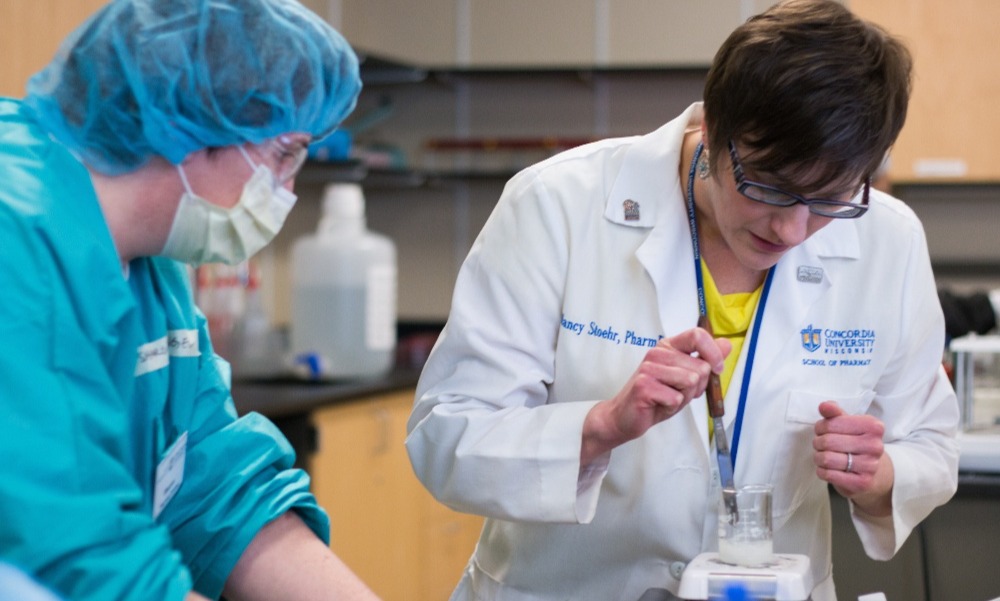
One of the best ways to learn about the career of a compounding pharmacist is to go to an expert in the field. And luckily, Concordia University has Dr. Nancy Stoehr as an Associate Professor in the School of Pharmacy. She has successfully found her niche in compounding pharmacy since earning her PharmD from the University of Wisconsin-Madison in 2006.
Dr. Stoeher earned her Board Certification of Compounded Sterile Preparations from the Board of Pharmacy Specialties in 2021. And in 2022, she earned her Master’s of Education in Teaching and Learning at Concordia to enhance her skillset as a pharmacy professor. Her teaching focus is pharmaceutical dosage forms and pharmaceutical compounding for the community patient.
Compounding pharmacists are chemical problem solvers
Typically, most patients can safely take manufactured products (medicines) that are made in a factory. Some patients cannot take these manufactured products for various reasons. They might be allergic to other chemicals in the manufacturing process. Or the manufactured product is in a dose or dosage form that the patient is unable to take. For example, babies cannot swallow tablets. If an infant’s medication is only produced as a tablet, a pharmacist can make a liquid solution that the baby can swallow.
Pharmacists can make medications for specific patients using individual chemicals. Think about the process of baking a cake using several individual ingredients. You combine eggs, flour, sugar, and other ingredients. The result? Well, your results may vary, but ideally, you end up with a perfect dessert. Similarly, the medications we take include more than a single drug. There are a lot of other components or inactive chemicals that go into the medication. These other components help to create a form of medication that can be safely administered to patients on their own. Inactive chemicals are added to the medication during the manufacturing process to help make a product of a certain quality.
Compounding pharmacists are scientific artists
Pharmacists need to develop an in-depth knowledge of science to understand what chemicals they can combine safely. Beyond book knowledge, it also takes a level of creativity and innovation to treat a specific patient for a specific outcome. Again, like the culinary sciences, pharmaceutical compounding requires pharmacists to be able to make a “pharmaceutically elegant” product. It has to be something that someone wants to take for the duration of their therapy. This could be as simple as matching a mint flavor with a green color. Or it can be as complex as making sure a cream is aesthetically pleasing as well as effective as a medication.
Compounding pharmacists work very closely with the prescriber and the patient before setting to work. A relationship must be formed between the prescriber, the pharmacist, and the patient before it is even legal to compound a medication for a patient. We call this the “compounding triad”. As a healthcare team, you want to try the manufactured drug products that are currently available before making a compounded medication. This relationship also allows the patient to advocate for their preferences and ideas in their medication treatment.
How do I become a Compounding Pharmacist?
First, you must receive a Doctor of Pharmacy (PharmD) degree. You can continue your education after pharmacy school by participating in a residency. There are some residencies throughout the United States that specialize in compounding pharmaceutical preparations. An independent pharmacy, owned by an individual or small group, is often the setting for a compounding residency. These are not big chain pharmacies that you see in department or grocery stores. A quality pharmacy program will provide you access to their network of connections for gaining residencies.
Alternatively, you may also earn board certification and add the letters BCSCP after your name (Board Certified Sterile Compounded Preparations). To maintain this certification, you need to earn 100 hours of continuing education every seven years, or you can simply retake the test.
Where else can I serve as a compounding pharmacist?
Using Dr. Stoehr as an example, she has chosen multiple pathways to serve others in compounding pharmacy.
- She is teaching this area of pharmacy to the next generation of pharmacists.
- She obtained her certification as a PCAB (Pharmacy Compounding Accreditation Board), Pharmacy, and DMEPOS (Durable Medical Equipment, Prosthetics, Orthotics & Supplies) Consultant through the Accreditation Counsel of Health Care in 2020.
- She has background experience as a pediatric compounding pharmacist for Skywalk Pharmacy. This is an affiliation of the Children’s Hospital of Wisconsin.
- Her past work also includes sterile compounding as a home infusion pharmacist and as a hospital pharmacist.
Dr. Stoehr also finds time to dedicate to research in the area of compounding pharmacy. Her research focuses on the stability and quality of compounded dosage forms, formulation development, and community compounding documentation systems. She looks forward to continuing the incorporation of service to patients in the community, with interprofessional communication, team building, and research for the betterment of community patients. She enjoys incorporating practice and research into her education of pharmacy technicians, pharmacists, and future pharmacists.
Dr. Stoehr is willing to further discuss the role of a compounding pharmacist with others interested in this field. You are welcome to contact her below to discuss how this field can provide you a rewarding career for a lifetime.